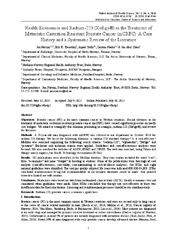Health Economics and Radium-223 (Xofigo®) in the Treatment of Metastatic Castration-Resistant Prostate Cancer (mCRPC): A Case History and a Systematic Review of the Literature
Permanent lenke
https://hdl.handle.net/10037/9116Dato
2015Type
Journal articlePeer reviewed
Tidsskriftartikkel
Sammendrag
OBJECTIVES: Prostate cancer (PC) is the most common cancer in Western countries. Recent advances in the treatment of metastatic castration resistant prostate cancer (mCRPC) have caused significant pressure on health care budgets. We aimed to exemplify this dilemma presenting an example, radium-223 (Xofigo®), and review the literature.
METHODS: A 74-year-old man diagnosed with mCRPC was referred to our department in October 2014 for radium-223 therapy. We faced the following dilemma: is radium-223 standard therapy? Is it cost-effective? Medline was searched employing the following search criteria: “radium-223”, “alpharadin”, “Xofigo” and “prostate”. Exclusion and inclusion criteria were applied. Guidelines and cost-effectiveness analyses were focused. We also searched the websites of ASCO, ESMO and ISPOR. The web was searched, using Yahoo and Google search engines, for Health Technology Assessments (HTAs).
RESULTS: 181 publications were identified in the Medline database. Only four studies included the word “cost”, three “economics” and none “budget” in heading or abstract. None of the publications were thorough of cost analysis (cost-effectiveness, cost-utility, cost-minimizing or cost-of-illness analysis). Six HTAs and eight national guidelines were identified. The cost per quality adjusted life years was indicated €80.000-94,000. HTAs concluded reimbursement being not recommendable or no ultimate statement could be made. One pointed towards a limited use with caution.
CONCLUSION: Guidelines were based on data from randomized clinical trials (RCTs). Health economics was not considered when guidelines were made. Most HTAs concluded this therapy not cost-effective or there was insufficient data for final conclusions. Licensing and reimbursement processes should be run simultaneously.
Beskrivelse
DOI: 10.5539/gjhs.v8n4p1
Creative Commons Attribution License 3.0


 English
English norsk
norsk